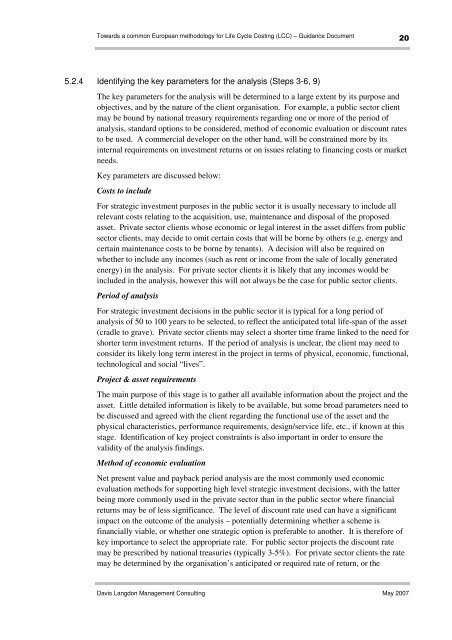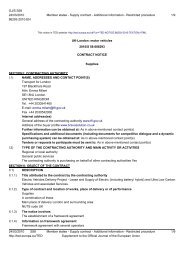Life cycle costing (LCC) as a contribution to sustainable construction ...
Life cycle costing (LCC) as a contribution to sustainable construction ...
Life cycle costing (LCC) as a contribution to sustainable construction ...
Create successful ePaper yourself
Turn your PDF publications into a flip-book with our unique Google optimized e-Paper software.
Towards a common European methodology for <strong>Life</strong> Cycle Costing (<strong>LCC</strong>) – Guidance Document<br />
20<br />
5.2.4 Identifying the key parameters for the analysis (Steps 3-6, 9)<br />
The key parameters for the analysis will be determined <strong>to</strong> a large extent by its purpose and<br />
objectives, and by the nature of the client organisation. For example, a public sec<strong>to</strong>r client<br />
may be bound by national tre<strong>as</strong>ury requirements regarding one or more of the period of<br />
analysis, standard options <strong>to</strong> be considered, method of economic evaluation or discount rates<br />
<strong>to</strong> be used. A commercial developer on the other hand, will be constrained more by its<br />
internal requirements on investment returns or on issues relating <strong>to</strong> financing costs or market<br />
needs.<br />
Key parameters are discussed below:<br />
Costs <strong>to</strong> include<br />
For strategic investment purposes in the public sec<strong>to</strong>r it is usually necessary <strong>to</strong> include all<br />
relevant costs relating <strong>to</strong> the acquisition, use, maintenance and disposal of the proposed<br />
<strong>as</strong>set. Private sec<strong>to</strong>r clients whose economic or legal interest in the <strong>as</strong>set differs from public<br />
sec<strong>to</strong>r clients, may decide <strong>to</strong> omit certain costs that will be borne by others (e.g. energy and<br />
certain maintenance costs <strong>to</strong> be borne by tenants). A decision will also be required on<br />
whether <strong>to</strong> include any incomes (such <strong>as</strong> rent or income from the sale of locally generated<br />
energy) in the analysis. For private sec<strong>to</strong>r clients it is likely that any incomes would be<br />
included in the analysis, however this will not always be the c<strong>as</strong>e for public sec<strong>to</strong>r clients.<br />
Period of analysis<br />
For strategic investment decisions in the public sec<strong>to</strong>r it is typical for a long period of<br />
analysis of 50 <strong>to</strong> 100 years <strong>to</strong> be selected, <strong>to</strong> reflect the anticipated <strong>to</strong>tal life-span of the <strong>as</strong>set<br />
(cradle <strong>to</strong> grave). Private sec<strong>to</strong>r clients may select a shorter time frame linked <strong>to</strong> the need for<br />
shorter term investment returns. If the period of analysis is unclear, the client may need <strong>to</strong><br />
consider its likely long term interest in the project in terms of physical, economic, functional,<br />
technological and social “lives”.<br />
Project & <strong>as</strong>set requirements<br />
The main purpose of this stage is <strong>to</strong> gather all available information about the project and the<br />
<strong>as</strong>set. Little detailed information is likely <strong>to</strong> be available, but some broad parameters need <strong>to</strong><br />
be discussed and agreed with the client regarding the functional use of the <strong>as</strong>set and the<br />
physical characteristics, performance requirements, design/service life, etc., if known at this<br />
stage. Identification of key project constraints is also important in order <strong>to</strong> ensure the<br />
validity of the analysis findings.<br />
Method of economic evaluation<br />
Net present value and payback period analysis are the most commonly used economic<br />
evaluation methods for supporting high level strategic investment decisions, with the latter<br />
being more commonly used in the private sec<strong>to</strong>r than in the public sec<strong>to</strong>r where financial<br />
returns may be of less significance. The level of discount rate used can have a significant<br />
impact on the outcome of the analysis – potentially determining whether a scheme is<br />
financially viable, or whether one strategic option is preferable <strong>to</strong> another. It is therefore of<br />
key importance <strong>to</strong> select the appropriate rate. For public sec<strong>to</strong>r projects the discount rate<br />
may be prescribed by national tre<strong>as</strong>uries (typically 3-5%). For private sec<strong>to</strong>r clients the rate<br />
may be determined by the organisation’s anticipated or required rate of return, or the<br />
Davis Langdon Management Consulting May 2007







